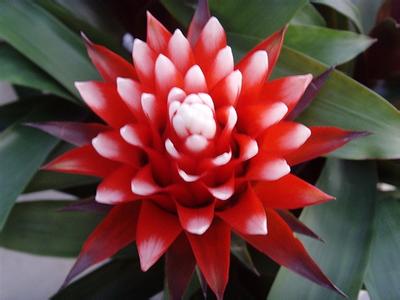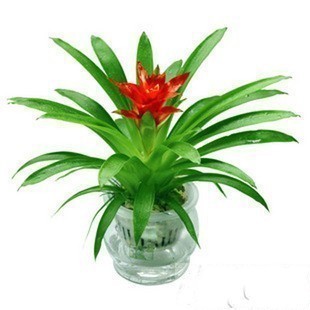Propagation methods of pineapple flower conservation methods of pineapple flower
Now indoor flower decoration is also gradually popular, indoor layout of plants is conducive to fresh air, but also plays a decorative role. What's more, indoor plants are used to change the luck of fengshui, but most people still take the good meaning of plants to decorate the interior. What the editor wants to introduce to you today is the pineapple flower. Let's take a look at the breeding method of the pineapple flower and the conservation method of the pineapple flower.

Propagation methods of pineapple flower
The propagation of pineapple can be divided into: cuttage propagation, ramet propagation, sowing propagation.
Ramet, the axils of the leaves at the base of the ornamental pineapple will continue to grow small buds, and when it grows 5-6 leaves, it can be cut off and propagated, and roots can be produced in about 1 month.
The cuttings can be combined with changing pots in spring to cut the small tubers from the tubers of the mother plant, or to use the roots of the old pineapple to avoid shade, moisturize and keep warm, and the soil is half of rotten leaf soil and plain sandy soil. when the root system grows to 2-3 cm, it can be planted.
Sowing: under the condition of 25 ℃ to 30 ℃, the seeds obtained by artificial pollination after flowering can emerge in about 4 weeks and grow into flowering pineapple plants in 3 to 4 years.
Conservation methods of pineapple flowers
For the conservation and management of pineapple after breeding, we can grasp these conditions from soil, water and fertilizer, temperature, light and humidity.
1. Soil: it is appropriate to use rotten leaf soil and 1x4 river sand to form culture soil, or it can be wrapped and planted with moss and bark blocks. Potted plants are filled with granular drainage with 1x4 to facilitate root ventilation and drainage; if a small amount of rotten chicken manure, cake fertilizer or bone meal can be put into the bottom of the pot, it will grow better.

2, lighting: pineapple flowers like a cool environment, can not be exposed to direct sunlight, but also need appropriate sunlight. At present, the light intensity of most cultivated varieties is 1.8-20,000 lux, but it is different in different cultivation stages and seasons.
3. Temperature: pineapple can adapt to a wide range of temperature and can grow at 5-37 ℃. The most suitable temperature is 10-18 ℃ at night and 21-32 ℃ at day, and the temperature difference between day and night should be more than 6 ℃.
4. Water and fertilizer: the ideal irrigation water is Rain Water, followed by surface water such as rivers and lakes. The state of water management requires no stagnant water at the bottom of the basin, mossy on the surface of the substrate and water in the leaf cup. As pineapple mainly relies on leaf cups to absorb nutrients, liquid fertilizer should be used. Pineapple flowers are sensitive to some elements, such as copper and chlorine can cause plants to blacken or even die; zinc can cause leaf tip drying; boron can cause leaf curl or shedding; excessive phosphorus can also cause pineapple flowers to show toxic symptoms, such as leaf tip drying up. The leathery leaves of pineapple have more demand for magnesium, and sufficient magnesium can make the leaves of some pineapple varieties (such as torch) emit unique metallic luster. Therefore, attention should be paid to the addition of magnesium in the nutrient solution, which is generally added according to 1max of potassium (potassium oxide).

5. Humidity: the air relative humidity most suitable for pineapple growth is 50-75%. In general, ventilation should be strengthened during periods of high temperature and humidity (relative humidity ≥ 80%); more water should be sprayed during high temperature and dry (relative humidity ≤ 40%); water should not be sprayed at low temperatures in winter, but when people feel stuffy, fans should be turned on to increase air convection.
After the pineapple blossoms, the central leaf clump dies and the collateral seeds continue to grow. When the daughter plant is 15 cm high, it can be removed from the mother plant and replanted with roots. In doing so, it can only be passed on from generation to generation, and the number of reproduction is limited. Therefore, it is best to change the basin in spring, cut off the small tubers that grow from the tubers of the mother plant, or use the young buds sprouting from the roots of the old plants to avoid shade, moisturize and keep warm. When the root system grows to 3 meters, it can be planted. If cultivated properly, a mother bead can reproduce about 10 plants a year.

In the case of dry climate, muggy heat and low humidity, the leaf edge and leaf tip of pineapple are easy to scorch, so to keep the basin soil moist, you can spray water to the leaves once or twice a day, and the cup-shaped part of the leaf pedestal can be filled with water. Pineapple plants were originally parasitic plants with underdeveloped roots and only small and short roots, so do not apply too much fertilizer to prevent root decay and yellowing of leaves.
How to raise pineapple flowers
Doing what you like is the key, because pineapple is native to the American rainforest and likes high temperature and humid climate. If you breed indoors, you need to pay attention to the sunlight, moisture and air. The indoor temperature of 15-20 ℃ is the most suitable for the growth of pineapple. In terms of temperature, pineapple is suitable for indoor culture, and wet soil is suitable for the growth of pineapple in peak season. Therefore, the leaves and surrounding areas should be sprayed with water several times a day during flowering to increase air and soil moisture.

Generally speaking, how to raise pineapple is to find out its growth habits, adapt and create a suitable growth environment, prolong the flowering period of pineapple according to its growth law, and bring more color to the room. in this way, the breeding method of pineapple, the conservation method of pineapple, can be mastered in the heart.
Because pineapple is native to the American rainforest, it likes high temperature and humid climate. If you breed indoors, you need to pay attention to the sunlight, moisture and air. The indoor temperature of 15-20 ℃ is the most suitable for the growth of pineapple. In terms of temperature, pineapple is suitable for indoor culture, and wet soil is suitable for the growth of pineapple in peak season. Therefore, the leaves and surrounding areas should be sprayed with water several times a day during flowering to increase air and soil moisture.

Generally speaking, how to raise pineapple is to find out its growth habits, adapt and create a suitable growth environment, prolong the flowering period of pineapple according to its growth law, and bring more color to the room. in this way, the breeding method of pineapple, the conservation method of pineapple, can be mastered in the heart.
Related
- Wuhan Hospital Iron Tree Blooming Result Was Instantly Frightened by the Gardener Master
- Which variety of camellia is the most fragrant and best? Which one do you like best?
- What is the small blue coat, the breeding methods and matters needing attention of the succulent plant
- Dormancy time and maintenance management of succulent plants during dormancy
- Minas succulent how to raise, Minas succulent plant pictures
- What are the varieties of winter succulent plants
- How to raise succulent plants in twelve rolls? let's take a look at some experience of breeding twelve rolls.
- Attention should be paid to water control for succulent plants during dormant period (winter and summer)
- Watering experience of twelve rolls of succulent plants
- Techniques for fertilizing succulent plants. An article will let you know how to fertilize succulent plants.



